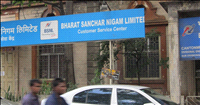ECONOMIC SURVEY 1999-2000: Production - agriculture
10 Apr 2007
1.15 Even though 1999 was the twelfth successive normal monsoon year and the countrywide seasonal rainfall was 96 per cent of long-term average, some states (Gujarat, Haryana, Kerala, Rajasthan, Tamil Nadu etc.) received lower than normal rainfall. The volatility in agricultural production is therefore likely to persist. The 1998-99 output level is unlikely to be achieved in 1999-2000 because of inadequate or erratic rainfall in some states. Production of pulses this year is expected to be 13.5 million tonnes, a decrease of 1.3 million tonnes over last year. Higher output of rice in 1999-2000 is unlikely to offset the decline in production of coarse cereals and wheat. Hence estimated food-grains output of 199.1 million tonnes in 1999-2000 could be lower by about 4 million tonnes, representing a decrease of 1.9 per cent over 1998-99. However, the good rains in late January and early February could lead to a better rabi production and thus raise total foodgrains output in 1999-2000 to a higher level than presently estimated.
1.16 With a very good sugarcane crop in 1999-2000, production is likely to be much higher than previous year. Sugar output is therefore likely to attain a new peak of 16.5 million tonnes. The oilseeds production is expected to be 21.6 million tonnes as compared to 25.2 million tonnes produced last year. The cotton production at 12.1 million bales is likely to be about the same as last year. In all other crops, particularly vegetables and fruits, the country has fared well this year. This is reflected in their low prices during the year. Because of the setback in oilseeds, pulses and coarse cereals, the GDP from agriculture and allied sectors is expected to grow by only 0.8 per cent in 1999-2000.
1.17 Real private investment (GCF) in agriculture has been rising over the nineties. From Rs. 9056 crore in 1993-94 it has risen to Rs. 12581 crore by 1998-99 (1993-94 prices). Public investment in agriculture has, however, declined during the same period so that the growth in total investment is only 21.7 per cent during this period. There is a need to shift the emphasis of public support for agriculture from subsidies to investment in rural and agricultural infrastructure and effective research and extension.
1.18 In agriculture a major initiative in crop insurance called National Agricultural Insurance Scheme was introduced in late 1999 which would cover all farmers and all food crops, oilseeds, horticultural and commercial crops. Incentives given in the budget for agriculture and rural development included:
- Cold chain for agricultural produce set up any where in the country will be entitled to five years tax holiday and 30 per cent deduction from profit for the subsequent five years. Besides, a new credit linked subsidy scheme for construction of cold storages and godowns was announced in the Budget.
- Increased funding for Watershed Development and Accelerated Irrigation Project Programme.
Featured articles

Lighter than air, yet very, very powerful
By Kiron Kasbekar | 03 Jan 2024
In March 2013 Chinese scientists pulled off a remarkable feat. They created the world’s lightest aerogel. Tipping the scales at a mere 0.16 milligrams per cubic centimeter – that’s a sixth of the weight of air!

COP28 explained: A closer look at COP28's climate change solutions
By Aniket Gupta | 27 Dec 2023
The 28th United Nations Climate Change Conference, also known as COP28, took place from 30th November 2023, to 13th December 2023, at Expo City in Dubai, United Arab Emirates.

What is a Ponzi scheme?
By Aniket Gupta | 06 Dec 2023
Ponzi schemes have long captivated the public imagination, drawing unsuspecting investors into a web of illusion and deception.

The Rise and Rise of HDFC Bank
03 Jul 2023
HDFC, which surged ahead of global majors like HSBC Holdings Plc and Citigroup Inc and left Indian peers like State Bank of India and ICICI Bank in market capitalisation, now ranks fourth largest among the world’s most valuable banks, after JPMorgan Chase & Co, Industrial and Commercial Bank of China Ltd and Bank of America Corp

India’s Millet Revolution To Enrich Global Food Basket
02 Apr 2023
Millets, a healthier and cheaper substitute to wheat and rice, are indigenous to many parts of the world, especially in the semiarid tropics of Asia and Africa, and offers a big scope for expanding production and consumption in the foodgrain deficient African continent

Market predator Hindenburg preys on Adani stock
06 Mar 2023
Almost a month after the damning report of short-seller Hindenburg Research on the Adani Group that claimed that the seven stocks within the group were about 85 per cent overvalued, one of the group's stocks, Adani Total Gas, closed at Rs835 on the BSE, down nearly 79 per cent from its 24 January level, almost close to reaching that valuation
Business History Videos

History of hovercraft Part 3...
By Kiron Kasbekar | Presenter: Kiron Kasbekar

History of hovercraft Part 2...
By Kiron Kasbekar | Presenter: Kiron Kasbekar

History of Hovercraft Part 1...
By Kiron Kasbekar | Presenter: Kiron Kasbekar










.jpg)









